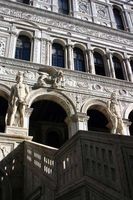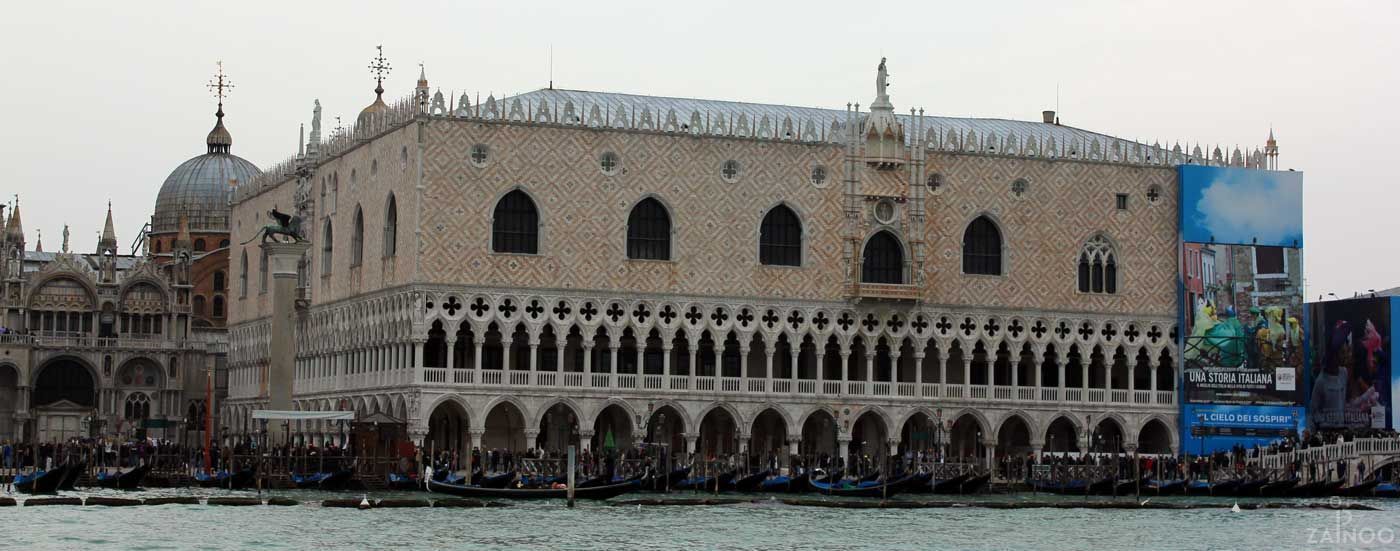The Doge's Palace (Palazzo Ducale)
Palace
The Doge’s Palace (Palazzo Ducale)
The former centre of Venice’s power
After the islands around Rivus Altus (Rialto) were settled, the Doge’s palace became the centre of power of Venice. It was here that the first timbers of the palace with its numerous towers were laid back in 814. Shortly after the palace, the first St Mark’s Basilica was built – as a private chapel of the Doge. In the 12th century a Byzantine official building with arcades and loggias was built to replace the fortified castle. In the mid14th century, when the number of council members had grown enormously and there was a huge lack of space, the council decided to reconstruct the Palazzo Ducale.
The Doge’s Palace from outside
The Palazzo Ducale essentially consists of three wings: the south wing facing towards the lagoon, the west wing towards the Piazzetta and the east wing including the Bridge of Sighs towards the canal side. To the north, the palace borders with the Basilica of St. Mark’s. The exterior facade consists of two-storey arcades with ogee arches and quatrefoil openings. This basement is topped by a closed construction of white and pink marble which is only interrupted by pointed arches and at the south and west facades by a balcony. The south wing and the southern facade represent the oldest part of the Doge’s Palace and were crucial for its further construction. Statues are perched on the corners and the balconies. They date from the 14th century and show the lion of St. Mark, the Roman goddess of justice Justitia with a sword and the archangels Raphael and Michael, as well as Noah, Adam and Eve. The Gothic Porta della Carta is the link between the Palazzo Ducale and the Basilica San Marco – the entrance for visitors is located on the southern side.
The courtyard
When you enter the Doge’s Palace through the south entrance you will reach the courtyard. You will see the two most obvious sights of the courtyard straight away: the Scala dei Giganti, the wide staircase towards the back of the court on the right, and the Arco Foscari, the richly decorated arch in the centre. The Scala dei Giganti, the steps of the Giants, was designed in 1483 by Antonio Rizzo and played an important role during the appointment of a new Doge. The Doge spoke his oath of loyalty from the top step before receiving his characteristic headpiece and regalia on assuming office. The Arco Foscari opposite was also constructed by Antonio Rizzo and features some of the most beautiful statues by the sculptor.
The interior of the Palazzo Ducale
Inside the Doge’s Palace there are, besides the Doge’s private apartments, meeting rooms, reception rooms, torture chambers and the prison. The palace was the republic’s centre of power and offered rooms for all government affairs. The magnificent interior was redecorated after a fire in the16th century. The most famous Venetian artists of the time, such as Tintoretto, Titian and Paolo Veronese, were of course involved in the decoration works. When entering the palace itself you should make sure you take a quick look at the Bocca di Leone, the lion’s mouth, to the right of the staircase. This was a mailbox where secret complaints could be deposited.
Scala d’Oro and Sala dell’Anticollegio
From the loggia you can reach the magnificently decorated Scala d’Oro, the golden staircase, to the second and third floor of the palace. The staircase, adorned with countless gilded stucco, was designed by Sansovino in 1538 and completed in 1577. Besides the beautiful ceiling decorations, the floor also deserves a special mention. If you look down the stairs it creates a three-dimensional impression. Go through the Atrio Quadrato, the vestibule, and the Sala delle Quattro Porte, the waiting room with four doors, to reach the Sala dell’Anticollegio – another waiting room. The main images on the ceiling in the previous two rooms were created by Tintoretto. The central ceiling fresco on the Sala dell’Anticollegio is by Veronese. Tintoretto also painted the four pictures next to the doors.
Sala del Collegio and Sala del Senato
The most important state visitors were received in the conference room of the senate, the Sala del Collegio. The ceiling paintings by Paolo Veronese reflect the power, glory and influence of Venice. In the border areas of his work you can see the seven virtues. The mural painting behind the Doge’s throne shows the Doge Sebastiano Venier who defeated the Turks at the Battle of Lepanto 1571. The ceiling paintings in the senate chamber, the Sala del Senato, are by Tintoretto. They too show the fame, glory and power of Venice. In the senate hall, 100 senators of Venice gathered twice a week to discuss the fate of the lagoon city.
Hall of the Great Council and private apartments of the Doge
Through further magnificently decorated halls and the armoury you will reach the Sala del Maggior Consiglio, the hall of the Great Council. At 54 metres in length, it is the largest hall of the Ducal Palace and offered enough space for up to 1,800 members of the High Council. All important decisions on matters of state were made here. An eye-catching highlight is the 7 by 22 metre-large mural painting “Paradise” by Tintoretto. It was started by Paolo Veronese and completed by Tintoretto after four years of work. When it was presented, it was the largest painting in the world. The small paintings of the 76 Doges are by Jacopo Tintoretto’s son, Domenico Tintoretto. The portrait, veiled with a black cloth, commemorates the Doge Marino Falier, who was beheaded because of high treason. Finally you will reach the private chambers of the Doge. Unfortunately they are empty. Each Doge brought his own belongings into the Doge’s palace and had to clear them out at the end of his reign. However, it is worth walking through the highly decorated and ornate rooms.
Prison and Bridge of Sighs
At the end of the visit to the Palazzo Ducale you will reach the prison. When the old prison, the Prigoni Vecchie, became too small, the new prison, the Prigoni Nuove, was built in the 16th century on the opposite side of the canal, east of the palace. Since 1603 both prisons have been connected by a famous bridge – the Bridge of Sighs. The bridge got its name during the Romantic era. The inspiration for the name came from imagining prisoners taking a last look at the freedom of the lagoon through the small window. In 1755 Casanova staged a spectacular escape from the prison with the help of a monk.
TIP: On request (at least 2 days in advance) you can go on a very special tour through the Doge’s Palace. Groups of at least two people can go on a one and a half hour tour of the palace and experience the secret passageways of the Venetian state police, who used an impressive system of secrets paths in the partition walls of the palace.
Entrance
€ 16,00 (The ticket "I MUSEI DI PIAZZA SAN MARCO" is valid for the Palazzo Ducale, Museo Correr, Museo Archeologico Nazionale e Sale Monumentali della Biblioteca Nazionale Marciana)
Opening hours
Discounts
Children from 6-14 years & students up to 25 years: € 8,00
Accessibility
Landing stage: Vallaresso San Marco or San Zaccaria









Tweet